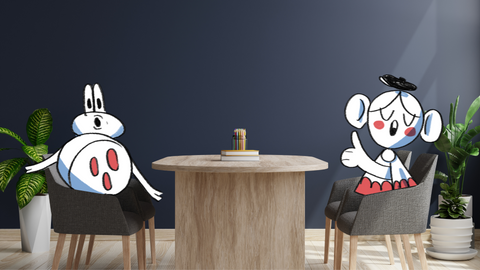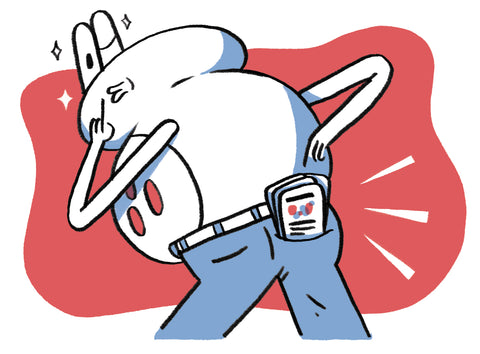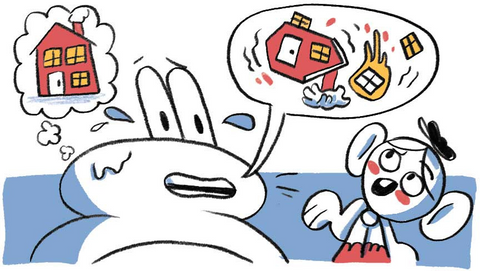ℹ️ Skip to key parts of the session by clicking on the chapter dots along the timeline.
The latest Pip Decks event, hosted by Steve Rawling (author of Storyteller Tactics) is everything you need to know about using the tactics to start telling your own stories.
The session starts with an interesting fact - did you know that 60% of our daily conversations are about other people? This frames gossip - stories - as an important way to share information.
And isn’t it strange, Steve points out, that we spend all that time talking to and about each other, yet when we sit down at a laptop to write to and about those same people - our language changes? We suddenly use awful language that we would never use in conversation. Jargon, buzzwords - we forget our story.
Here’s a little test Steve uses with people who have written their mission statement, or company values, or some other brand wording.
Imagine you’re sitting at home one evening and the phone rings. It’s your mum! She asks how you are, and you tell her you’re having a great day. She asks why, so you tell her: “Well, we’ve fully integrated several stakeholder expectations on our customer journey map!”
Even the most committed parent in the world is likely to change the subject out of sheer boredom. So why do it to your audience?!
So the first tip of the session: tap into your own natural ability to tell stories.
How do we use stories when we are talking or writing about our work?
We all talk to people - convince them, persuade them, bring them on our journey - about our work. Stories are the best tool for this!
There are seven desert-island cards that Steve focuses on to start with. Each helps you with a different stage of the storytelling process - it’s the ‘head’ of a family of similar tactics.
- The Dragon & The City
- Story Listening
- Trust Me, I’m an Expert
- Pitch Perfect
- Man in a Hole
- Movie Time
- Story Bank
The simplest way into the deck is to take one or two of these as your starting point.
The Dragon & The City
The dragon is on the box and the first card - he’s a key feature! Not just because dragons are cool, but because it represents chaos in stories. Threat! Danger! But also - opportunity. It’s the great unknown. It guards treasure. So it’s simultaneously scary and exciting - it’s a great way to start a story. Enter: The Dragon & The City.
Steve uses the pandemic as an example. At the start of 2020, COVID-19 arrived unexpectedly and changed our worlds completely. It cost us, damaged us - business went under. It also pushed us to do things we should have done anyway (remote meetings instead of flying around the world).
Story Listening
This is an ‘Explore’ tactic - Steve strongly advises that listening is probably your most useful skill! Get the stories and wisdom out of others. The Story Listening card and others in the group helps you see the world through stories, and to get facts and information out of people in story format (people don’t really remember facts very easily - but they can work with stories). These tactics are particularly useful if you work in research.
Trust Me, I’m an Expert
Trust Me, I’m an Expert makes you turn your focus onto yourself and think about your role as the messenger that delivers the story. A significant amount of whether or not your audience listens to you is tied up in who you are and why they should trust you. The family of ‘Character’ cards help you to star in your own story.
Pitch Perfect
A ‘Function’ card - lots of us have to pitch. We’re trying to sell or persuade in a small, formal window. You’re going to stand up in front of people - this card gives you a storyish shape to what you need to say in order to be persuasive - to get 'Pitch Perfect', if you will.
Man in a Hole
This is a story structure (there’s a run-through after this bit of the session). It’s one of the most useful cards in the deck. Claire (attendee) said she already loves Man in a Hole! Steve feels sure that everyone will soon feel the same.
Movie Time
This is covered later in the session - Movie Time is a great tactic to help you include the elements you need to put your audience into the story so that they can imagine and even feel what’s happening. This helps them remember the story so much more effectively.
Story Bank
Story Bank helps you to organise your stories. Great storytellers are rewarded with attention, time and money (see Netflix and good books!). We also punish bad storytellers - those who tell the same story twice (boring!) or break a confidence (that’s not an appropriate story) or steal stories.
Story bank helps you avoid these issues and systematically share stories within a team so that you know each other's stories. Social capital is stored up in these stories!
Steve has two or three words for each of his 250+ stories that prompt him to remember the story. But the meta-data - who he has told the story and where it came from - needs to be recorded somewhere.
Movie time
Here's the Movie Time tactic page. Audience participation here: hands up everyone who has been to the Arctic. No one has!
Imagine that you’re there. You’re walking across the ice - it’s very cold - there’s a beautiful blue sky. The sun is shining down on the ice as you walk across the snow (crunch crunch crunch).
You stop and stand very still - you can see, off in the distance, a big fat seal basking on the ice. But you can see a huge polar bear sneaking up behind him! The bear slips into the icy water and starts to approach the seal.
Suddenly, he hauls himself out of the water, throws himself across the last five yards and lands on the seal. The seal starts panicking and thrashing around, trying to flop away. But it’s too late. The polar bear bites it.

What I have just given you (says Steve) is a bunch of words, right? No images or video - just words. You process those in your brain using the visual cortex. It’s the same area that processes what comes in through your eyes. It’s the same if you are listening or reading - those words become a movie in your head to help you understand them.
Even better… you put yourself in the movie. You can hear the crunch. Your motor neurones (which control your arms, legs, jaw etc) - process the information about the seal thrashing around. When the seal panics, your emotional centres process those words. When you tell a story, you have the potential to put people in a movie where they aren’t just watching, but they are feeling what’s going on… if you use the right words.
The two key ingredients of the Movie Time tactic are Action and Emotion. Action: where are we, what’s happening and what’s coming next? But make it visual! Emotion: who’s involved, what’s at stake, how does it feel? But how does it feel emotionally and physically?
Those two elements give a rich movie that your audience can see themselves in. Steve gives a business example:
I was at Trinity College in Dublin, on my way to teach storytelling to professors. On my way into the college, I stopped for a coffee. The point of sale for the Lavazza brand was eco-friendly ‘Tiera’. They had a panel that said ‘This is the Tiera story’. So I thought “Well, I better read that!”. Anyway… it was crap. It wasn’t a story at all. What it was was a statement of value. “We believe in improving the environmental and social conditions of our coffee-growing communities.” I couldn’t have remembered it, so I took a photo. If that’s corporate storytelling - I can make some money!
So I looked at other eco-friendly coffee brands online. Rainforest Alliance for example - so I checked their website and the first thing you see is a photograph of a woman (called Leticia). She farmed coffee in the highlands of Guatemala. Right, let’s invent a little story about her: when she was ten years old, she left school to go and work on her dad’s coffee farm, because she had to. But, she wanted her daughter to be able to stay in school to become a doctor. But how could that happen? Well, it can - because she’s finally getting paid a fair price for her coffee, because she works with Rainforest Alliance.
Both coffee brand stories have meaning. They matter. They are moral stories. But the Lavazza story only gives you that meaning, and it’s instantly forgettable. It doesn’t give you a movie. Rainforest Alliance gave you a proud mother, farming the land, who wants the best for her daughter - and you can imagine yourself in Guatemala, even if you’ve never been.

This is one of the most successful tactics I use with clients because they often start out just giving facts (important ones) that I can’t see in my head as a movie.
The interesting thing is that all of us go through our professional lives having lots of experiences - lots of little moments happen as we build our careers. Lots of movies happen in our lives.
Then when we try to write, we abstract the wisdom from those moments, and we generalise, and we try to give others the benefit of our experiences. But sometimes, you have to go back into the moment and find the movie, so that they can experience learning it for themselves.
The two words you use to help you do that? “For example…” That’s how you pull out a movie moment. And if you want it to stick, you identify the action and the emotion… and then you share what you mean.
Sometimes Steve gets pushback on using emotions, particularly from quiet and serious people. The emotional dashboard tactic can help you to find the emotion in the story, even if it is difficult or awkward for you!
So that’s Movie Time, the best card in the deck to help you break away from boring business writing and getting into storytelling that helps people discover the wisdom you want to share with them.
Man in a hole
This is also the best card in the deck (and here it is).
This is an example of a story arc. Story arcs are incredibly useful. This one takes you from your comfort zone through experiencing a trigger and ensuing crisis, before describing your recovery and ending in a better place than you were when you started.
It’s called a man in hole because you imagine you’re walking along in your comfort zone and then you fall into a hole - either through a trip, or a push! Any of us can fall into a hole. None of us can fall out of one. You must climb out; pick yourself up, dust yourself off. And when you get out? You go to a better place, instead of returning to your comfort zone where that hole is a threat.

It’s the story of the first day at school. You’re comfortable at home, and then all of a sudden you’re surrounded by scary big kids and new experiences. But you stuck it out - and became one of those big kids. Staying in your comfort zone would result in you becoming a giant child! Change is scary - that’s why you can’t go straight to a ‘better place’ from your comfort zone. You have to leave old things behind that aren’t useful, and learn new stuff that is.
That’s the power of this card: it’s what we go through every day in life. That’s why it works so well… it mirrors our experiences.
Linking cards together
So how do you link cards together? The story arc gives you a structure for your story (five distinct stages of your story). But you still need to create the movie - so along the way, what movie will you play? What does a comfort zone look like (action/emotion)? What did the crisis look like/feel? Example:
In February 2020, I ran a business that was about face-to-face training. I lost all my clients in a week when the pandemic came along. So I was sitting in my office thinking what am I going to do? I’ve got no work, and no sign of any future work. Pretty scary! Then I looked at what other people were doing - online presentations and training - and I thought “You know what? I can do better than that!”. And I should be able to, because I used to work in TV, so I’ve lots of on-screen experience.
So, I decided to switch all my training to online - and by the end of that year I was turning over more than I had the year before - and that’s the ‘better place’. So that’s the Man in a Hole story with a little bit of Movie Time dropped in.
Some of the cards give you the big picture - e.g., concept cards - while others give you little moments within the story, e.g., style cards. You’ll find your own links, too.
Other ways to start
Five days to become a better storyteller.
This blog post talks you through another way into the cards. It gives you a task to focus on each day: listening, telling a story casually, writing a storyish email, persuade someone with a story, tell a big-picture story in a presentation.
Story recipe cards
There are seven recipe cards that group different tactics together for different purposes, such as explaining research or creating a story that sells.
Steve has printed these out and used them for in-person meetings too. All seven recipe cards were on the wall and in the break people could take a look and choose one to do in the second part of the workshop. He used dot voting to decide which to do.
Join an expert-led event
And of course, you can join the monthly deep dives into one card to find out how to get started - and the recordings are all in the Vault, and there are examples in the Storytelling blog, too. And if you’re on Slack? Just ask a question - your peers and the card authors will get back to you quickly.
Questions
Daniel asked: How do you use the cards together?
This was asked prior to the section about linking the cards together - you can watch that section of the video or read the Linking cards together section of this blog for more detail.
What we tried to do when we designed the cards was to create cards that work as completely standalone tactics. However, we believe that there’s a way of linking each card to at least one other. This concept is highlighted in the Man in a Hole walkthrough. For some people, the links feel confusing - especially at first - so feel free to ignore them and just use one card at a time!
CJB: How do I choose the right card? Do I have to read every card first to see which is appropriate?
There are different categories - the Desert Island cards listed above are a good example of each category. So if you read those and then use the Story Building System (which works like a flow chart), you can start to work out which stage of the journey you’re at and which card will help you the most. The ‘Recipe’ cards combine different tactics to help you solve different problems (e.g., stories that sell).
Thank you to Steve for another interesting session, and to everyone in the Pip Decks community that came along. See you at the next one!









